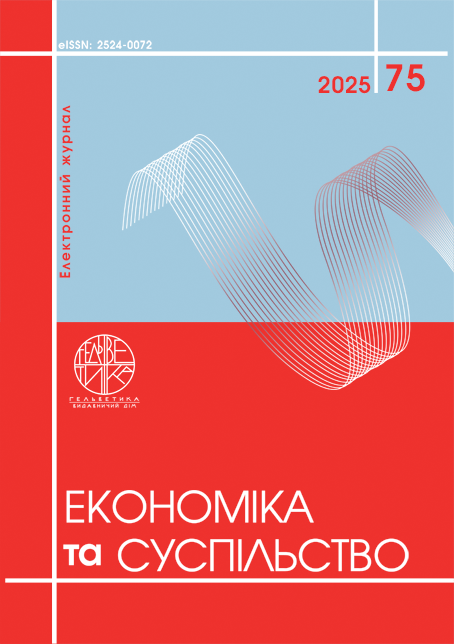HOUSEHOLD SAVINGS AND INVESTMENT SHARES IN THE EU: DYNAMICS AND CHALLENGES OF UNCERTAINTY
Abstract
This article provides a comprehensive analysis of the dynamics and structure of household savings and investment shares in the European Union and the Eurozone from 2018 to 2024, focusing on household financial behavior under conditions of heightened uncertainty. The research objective is to identify key trends, assess the impact of major crises, and quantify the level of household caution. The study is based on quarterly data from Eurostat and employs methods of statistical analysis, comparison, and synthesis. The analysis reveals a strong inverse relationship between the household savings rate and the investment rate, a dynamic that intensifies significantly during periods of crisis. The study distinguishes between two phases of rising savings: the "forced savings" during the COVID-19 lockdowns, driven by consumption restrictions, and the "precautionary savings" from 2022 onwards, motivated by the energy crisis, high inflation, and geopolitical risks associated with the full-scale Russia-Ukraine war. This shift reflects a rational "flight to liquidity" as households prioritize financial security over long-term returns. To quantitatively measure this sentiment, the article introduces and calculates the Household Caution Index (HCI), defined as the ratio of the savings rate to the sum of the savings and investment rates. As of Q4 2024, the HCI for the EU stood at 0.62, indicating a high degree of risk aversion and a prevailing preference for liquidity. This finding is further substantiated by an analysis of the structure of household financial assets, which shows a marked increase in the share of highly liquid assets, primarily bank deposits (exceeding 41% of total financial assets by the end of 2022), at the expense of long-term investment vehicles such as pension funds and life insurance products. The study also highlights significant heterogeneity in asset structures among EU member states. Based on the identified persistent trends, a short-term forecast for the end of 2025 is presented, projecting a continued increase in the savings rate and a decline in the investment rate. The findings underscore the challenge that heightened uncertainty poses to the efficient transformation of household savings into productive investment, with significant implications for long-term economic growth.
References
Brussels: European Fund and Asset Management Association (EFAMA) (2024). Household participation in capital markets. Available at: https://www.efama.org/sites/default/files/files/Household%20participation%20in%20capital%20markets_final.pdf (accessed May 28, 2025)
Eurostat (2024). Households – statistics on income, saving and investment. Available at https://ec.europa.eu/eurostat/statistics-explained/index.php?title=Households_statistics_on_income,_saving_and_investment (accessed May 28, 2025)
Eurostat Database (2024). Key indicators, quarterly – nasq_10_ki. Available at: https://ec.europa.eu/eurostat/databrowser/view/nasq_10_ki__custom_16927410/default/table?lang=en (accessed May 28, 2025)
Eurostat (2024). Thematic glossaries. Available at: https://ec.europa.eu/eurostat/statistics-explained/index.php?title=Thematic_glossaries (accessed May 28, 2025)
Колобердянко, І., & Золотова, Х. Заощадження домогосподарств як чинник стійкості економіки держави. Проблеми і перспективи економіки та управління. 2024. (№ 3(27), С. 211–217. https://doi.org/10.25140/2411-5215-2021-3(27)-211-217 (дата звернення 30.05.2025)
Маршук, Л., & Поліщук, К. Особливості заощаджувальної поведінки домогосподарств України в умовах пандемії. Економіка та суспільство. 2024. №25. https://doi.org/10.32782/2524-0072/2021-25-87 (дата звернення 30.05.2025)
Brussels: European Fund and Asset Management Association (EFAMA) (2024). Household participation in capital markets. Available at: https://www.efama.org/sites/default/files/files/Household%20participation%20in%20capital%20markets_final.pdf (accessed May 28, 2025)
Eurostat (2024). Households – statistics on income, saving and investment. Available at https://ec.europa.eu/eurostat/statistics-explained/index.php?title=Households_statistics_on_income,_saving_and_investment (accessed May 28, 2025)
Eurostat Database (2024). Key indicators, quarterly – nasq_10_ki. Available at: https://ec.europa.eu/eurostat/databrowser/view/nasq_10_ki__custom_16927410/default/table?lang=en (accessed May 28, 2025)
Eurostat (2024). Thematic glossaries. Available at: https://ec.europa.eu/eurostat/statistics-explained/index.php?title=Thematic_glossaries (accessed May 28, 2025)
Koloberdyanko, I., & Zolotova, K. (2022). Zaoshchadzhennia domohospodarstv yak chynnyk stiikosti ekonomiky derzhavy [Household savings as a factor of state economic resilience]. Problemy i perspektyvy ekonomiky ta upravlinnia – Problems and Prospects of Economics and Management, (vol. 3(27), pp. 211–217. Available at: https://doi.org/10.25140/2411-5215-2021-3(27)-211-217 (accessed May 30, 2025)
Marshuk, L., & Polishchuk, K. (2021). Osoblyvosti zaoshchadzhuvalʹnoi povedinky domohospodarstv Ukrainy v umovakh pandemii [Peculiarities of household saving behavior in Ukraine under pandemic conditions]. Ekonomika ta suspilʹstvo – Economy and Society, vol. 25. Available at: https://doi.org/10.32782/2524-0072/2021-25-87 (accessed May 30, 2025)

This work is licensed under a Creative Commons Attribution 4.0 International License.


